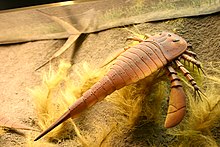Merostomata
| Merostomata Temporal range:
| |
|---|---|

| |
| Reconstruction of Eurypterus (Eurypterida) | |

| |
| Five views of Limulus polyphemus (Xiphosura) | |
| Scientific classification | |
| Domain: | Eukaryota |
| Kingdom: | Animalia |
| Phylum: | Arthropoda |
| Subphylum: | Chelicerata |
| Clade: | Prosomapoda |
| Order: | Xiphosura Woodward, 1866 |
| Orders | |
Merostomata is a class of chelicerate arthropods that contains the extinct Eurypterida (sea scorpions) and the extant Xiphosura (horseshoe crabs). The term was originally used by James Dwight Dana to refer to Xiphosura only, but was emended by Henry Woodward to cover both groups.
Etymology
[edit]The name "Merostomata" derives from the Greek roots μηρός (meros, "thigh") and στόμα (stoma, "mouth"), in reference to the animals' possession of appendages which are mouthparts at their proximal end, but swimming legs at their distal end.[1]
History
[edit]The scientific consensus at the beginning of the 20th century was that these two marine groups were closely related, and only more distantly related to the terrestrial Arachnida.[2] Some more recent analyses suggest the grouping Merostomata is not monophyletic, with Xiphosura being basal to a clade comprising Eurypterida and Arachnida.[3] Other recent analyses support the monophyly of this group.[4] The Xiphosura are estimated to have diverged from the Arachnida 480 million years ago.[5]
The shared features of the two groups traditionally grouped in the Merostomata are now thought to be retentions of primitive conditions (symplesiomorphies), thus the name Merostomata has been recommended to be abandoned.[3]
However, a 2022 analysis recovered the monophyly of Merostomata, as opposed to a monophyletic Arachnida, with Xiphosura as the only modern representative in a derived position, indicating the convergence of several characteristics that supposedly united the arachnids.[6]
References
[edit]- ^ "Literary Notices – A monograph of the British Fossil Crustacea, belonging to the Order Merostomata. Part 1. Pterygotus Anglicus, Agassiz. Pages 1–44. Plates i.–ix. By Henry Woodward, F.G.S., F.Z.S., of the British Museum". The Intellectual Observer: Review of Natural History, Microscopic Research, and Recreative Science. 11: 233–234. 1867.
- ^ J. A. Dunlop & P. A. Selden (1998). "The early history and phylogeny of the chelicerates". In Richard A. Fortey & Richard H. Thomas (eds.). Arthropod relationships. Volume 55 of Systematics Association Series. Springer Verlag. pp. 221–236. ISBN 978-0-412-75420-3. Also available as PDF[permanent dead link]
- ^ a b Colin Tudge (2002). "Spiders, scorpions, mites, eurypterids, horseshoe crabs, and sea spiders. Subphylum Chelicerata and Subphylum Pycnogonida". The variety of life: a survey and a celebration of all the creatures that have ever lived. Oxford University Press. pp. 309–326. ISBN 978-0-19-860426-6.
- ^ Garwood, Russell J.; Dunlop, Jason A. (2014). "Three-dimensional reconstruction and the phylogeny of extinct chelicerate orders". PeerJ. 2: e641. doi:10.7717/peerj.641. PMC 4232842. PMID 25405073.
- ^ Davide Pisani; Laura L. Poling; Maureen Lyons-Weiler; S. Blair Hedges (2004). "The colonization of land by animals: molecular phylogeny and divergence times among arthropods". BMC Biology. 2: 1. doi:10.1186/1741-7007-2-1. PMC 333434. PMID 14731304.
- ^ Ballesteros, Jesús A; Santibáñez-López, Carlos E; Baker, Caitlin M; Benavides, Ligia R; Cunha, Tauana J; Gainett, Guilherme; Ontano, Andrew Z; Setton, Emily V W; Arango, Claudia P; Gavish-Regev, Efrat; Harvey, Mark S; Wheeler, Ward C; Hormiga, Gustavo; Giribet, Gonzalo; Sharma, Prashant P (2022-02-03). Teeling, Emma (ed.). "Comprehensive Species Sampling and Sophisticated Algorithmic Approaches Refute the Monophyly of Arachnida". Molecular Biology and Evolution. 39 (2): msac021. doi:10.1093/molbev/msac021. ISSN 0737-4038. PMC 8845124. PMID 35137183.
External links
[edit] Media related to Merostomata at Wikimedia Commons
Media related to Merostomata at Wikimedia Commons
